On July 10, Sue posted Bird Brains maintaining that birds do have different characters – which I definitely agree with.
Taking things a step further I now wonder if bees have different characters too. I have just met a bee with attitude.
I must admit that it is really “bee time” over here and I am having plenty of models to take photographs and identify (hopefully).
Usually they pay little attention to me and I have to follow their movements as they visit the flowers but this one seemed curious of the camera.
Luckily I had my trusty assistant on hand to photograph my friendly bee.
She was certainly not camera shy but had not quite got the idea of posing in an alluring position on a colourful flower.
Tired of posing she seemed up for a game of hide-and-seek. I think she has the advantage over me for this game.
I thought it was time for my trusty assistant to borrow my camera which was equipped with my Macro lens to see if we could get a close up.
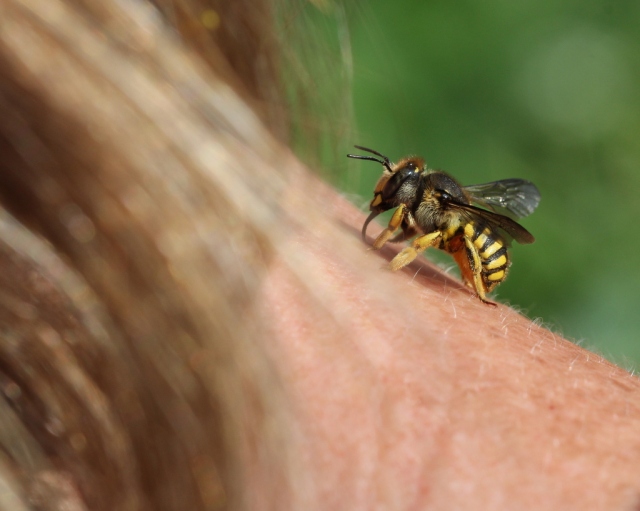 Isn’t she sweet! I would call that a bee kiss and we haven’t even exchanged names.
Isn’t she sweet! I would call that a bee kiss and we haven’t even exchanged names.
I think she is Anthidium manicatum but I am not too sure about her species name.

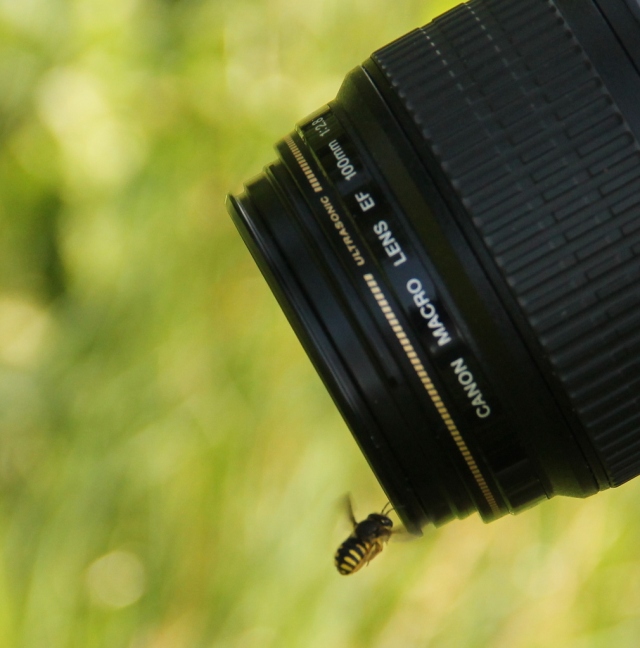
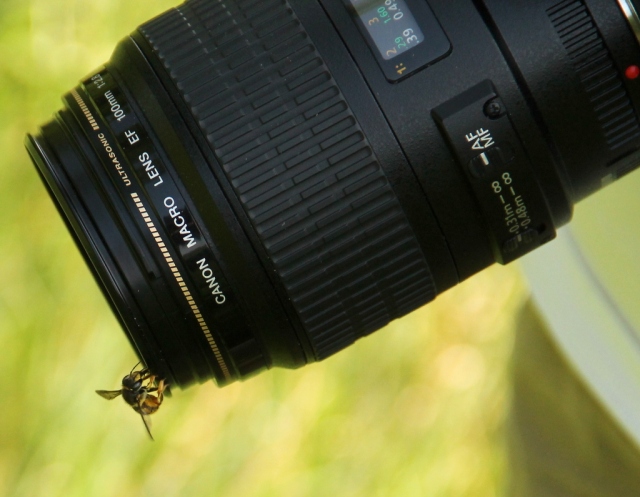

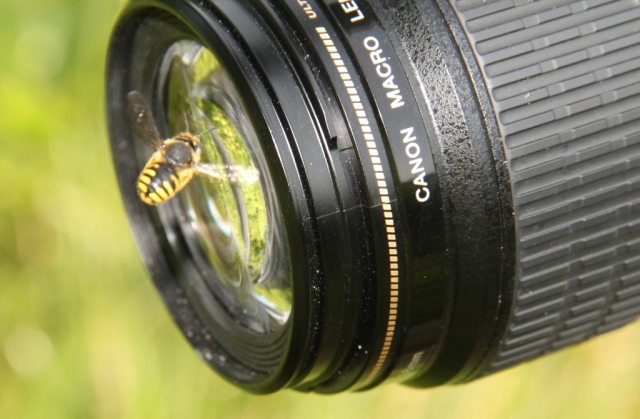
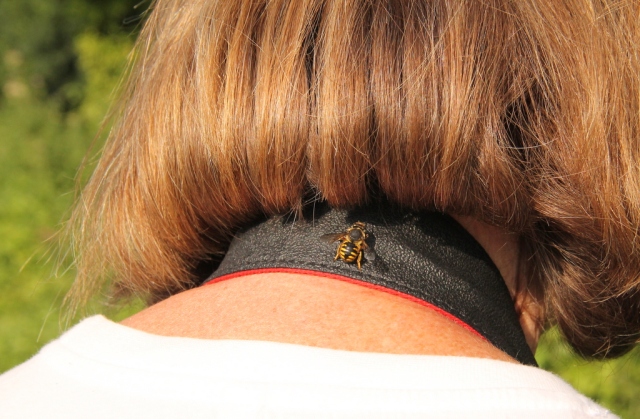
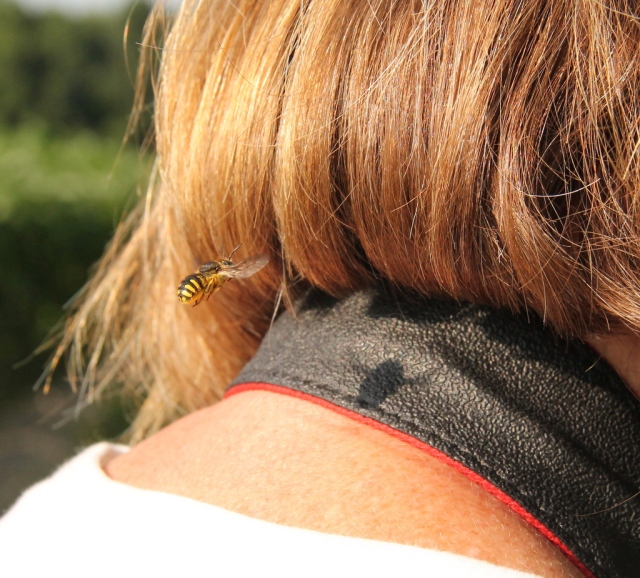
Looks like she might be enjoying your sweat – was it hot?! For a bee she seems surprisingly keen to look like a wasp.
LikeLike
I must admit this has never happened to me before. These bees like my lavender and nepeta. They are also called carder bees as they collect the hairs from leaves to make fluff like cotton wool to use in their nests. I have lots of fluffy plants like Lychnis coronaria and Stachys but I’ve yet to see the females making up their bundles of fluff.
LikeLike
She must be called Anthia!
Great set of shots…
and most certainly was after your body salts…
or even just moisture…
we got up to a dry 35 Centipedes at 27% Humility yesterday.
Saw first glowing wurrums Tuesday…
two…
one in a new spot…
very near where I’d seen a larva at the w/e…
so looks like we have a new grouping in the potager…
the other was by the strawberry “troughs”… a regular spot.
If only the “krill” would depart/vanish/get eaten, I’d go out on another hunt.
LikeLike
Love the name! Thank you for reminding me about the glow worms, I haven’t looked for any yet. I only usually get one or two and I have had one in my strawberries too.
LikeLike
That is amazing! In the last shot, it definitely looks like the bee is lapping up something (sweat?) with its long proboscis. I assume that is your neck getting “kissed”? You are brave!
LikeLike
I’ve never been stung by a bee despite always getting in their way with a camera. I think it’s mainly the honey bees that can turn nasty if you annoy them. Some of the other bees can sting but seemingly it is a very mild sensation, a bit like being touched by one nettle sting.
LikeLike
what incredible shots you got! I am yet to get a decent bee shot with my bridge camera. I’m looking to get a canon 100mm macro lens for canon EOS. I see you have one, how would you rate it?
LikeLike
I thought long and hard about it as I think it is a lot of money for a hobby. I asked a couple of the photographers I follow on WordPress and I found their comments very helpful. I have been very pleased with it. It is the cheaper version without the image stabilisation. It has enabled me to take pictures of bees so that I can see their mandibles and other bits to help with identification. You have to realise if you go that close up you don’t have much depth of field so it may not be the best if you wanted a picture of a bee on a lovely flower but I suppose you realise that yourself. It was only the last photograph that my husband took with the 100mm. The others he took with my kit lens 18-135 mm (Image stabiliser) on his Canon EOS 1100D.
LikeLiked by 1 person
That’s really useful. Thanks for such a comprehensive reply!
LikeLike
A very nice-looking bee . . .
LikeLike
I’m glad you like her, there are a lot of them around here at the moment. I had never seen them until this year. Taking photographs has made me a lot more observant than I used to be.
LikeLike
. . . learning to see . . . photography is one of the easiest paths (in my opinion).
LikeLike
I agree with Sue, you’re brave to not panic when the bee was on your neck.
LikeLike
I really like when the bees occasionally sit on you. They are never “out to get you” and very gentle.
LikeLike
I still think you’re brave.
LikeLike
Anthidium are certainly feisty little things. I watched one the other day guarding a patch of stachys (lamb’s ears), see off all comers including the violet carpenter bees. Later I got photos of one gathering the fluff from the lamb’s ears. A couple of years ago I got photos of one gathering fluff off the underneath of our chasselas grape leaves. It was so quiet in the orchard I could hear the scraping noise, which was what alerted me to the bee’s presence.
LikeLike
Fantastic! I’d love to hear them gathering their nesting material. I am trying to keep an eye out for that. They are still busy mating at the moment so I still have hope.
LikeLike
What kind of perfume were you wearing? You clearly smelled sweet. Great photographs of a darling little bee.
LikeLike
Thank you Laura, everybody else has been discussing the heat and talking about sweat. There was an alternative that I was wearing an extremely expensive and alluring French perfume and the bee was completely overcome with it and mistook me for an exotic flower. Unfortunately, I wasn’t wearing any perfume.:)
LikeLike
A very adventurous bee. Would it be scouting? Checking you out as potential source of ?????
LikeLike
Go on…say it SWEAT. I really don’t know, I haven’t read anywhere that bees collect anything else but pollen, nectar and tree resin (propolis – well the honey bees do). She was certainly one confused bee.
LikeLike
Sweat? Maybe! But I was wondering more if it was something about the sheen on your clothes or your hair indicating a potential source of fluff for the carder bee. Wrong time of year to be fluff sourcing?
LikeLike
Oh, that’s a better idea! Definitely fluff gathering season. She just got her lines crossed with the camera and its shine perhaps.
LikeLike
Yes, and your white T shirt looks like a potential source of good fluff 🙂 especially if one’s vision was altered by the shine of the lens!
LikeLike
I don’t know about carders but it’s well documented that honey bees also collect water. In the summer honey bees use it to keep the colony cool, by hanging it in the cells and fanning. They prefer ‘dirty’ water from sources like bird baths or ponds to fresh new water from a tap, possibly because they can locate it through smell more easily. Not that your neck is dirty! But possibly sweat might smell nice to a bee and contain salts and other minerals they can benefit from.
LikeLike
Possible. I know butterflies will sit on your skin in search of minerals. Doesn’t explain its liking of the black, angular camera, though. No sweat on the camera lens.
LikeLike
I understand the point you are making, but wow, the photos are absolutely amazing.
LikeLike
I’m glad you enjoyed the photos. It was a fun moment interacting, as if the bee was playing with me.
LikeLike
Some insects certainly seem more agressive than others, and some more passive but I don’t know if that qualifies as having different character. Bumblebees don’t seem to care how many pictures I take of them.
LikeLike
The male Anthidium is very aggressive towards other males in “his” territory and none to gentle with the females either! But that is just the basic instinct, I expect their are shifts away from normal.
LikeLike
I enjoyed this post. Great close ups! 😀
LikeLike
I love taking close-ups of bees, my passion.
LikeLike
Interesting to see your pets 🙂
LikeLike
I love my bees!
LikeLike
Good to see that 100mm at work in the last picture. I don’t know if I’d have been as sanguine as you at having a bee on my neck. Yesterday I was taking closeups of some paper wasps and after a while one of them flew at me. I didn’t stay around long enough to find out if it felt threatened or was just curious.
LikeLike
I’m very pleased with my lens – it is great for me quality/price – and your advice was a great help to me.
I think honey bees and wasps give the solitary bees a very bad image – they are not aggressive towards humans.:)
LikeLike
You’re made of sterner stuff than me, Amelia; despite my love of bees, I’d have been leaping around like a shrieking Sheila if anything landed on me!
LikeLike
You’d have nothing to worry about. Its honey bees and wasps that can turn nasty.
LikeLike
So cute!
LikeLike
He is a favourite of mine.
LikeLike
Can confirm Anthidium manicatum, the European wool carder…these guys definitely have attitude. I have seen them knock other bees out of the air.
LikeLike
Thanks for the confirmation. I have seen the male grab the female and he just pounces on her. She tries to keep a low profile but doesn’t have a chance when he spots her and he is larger than her too.
LikeLike
Oof, I always feel quite bad for the females.
LikeLike
Pingback: Living in France | a french garden